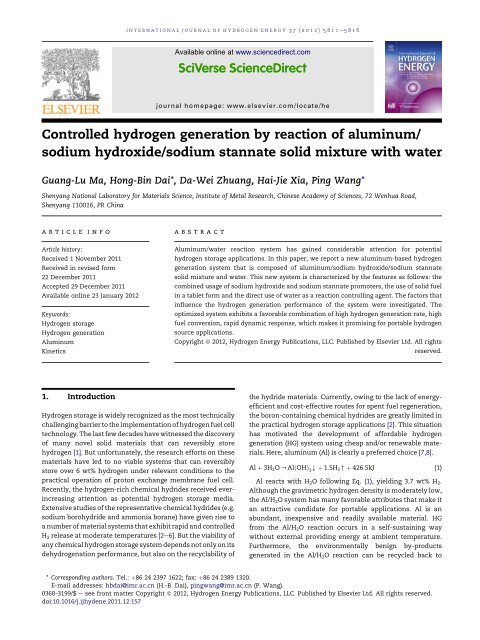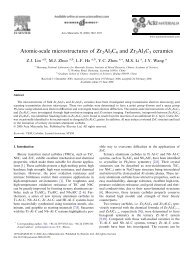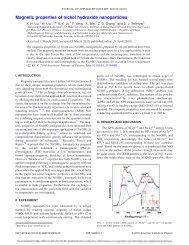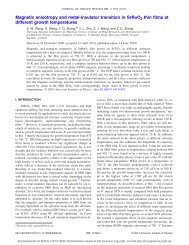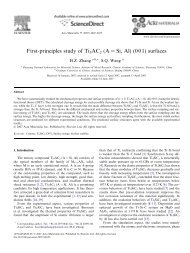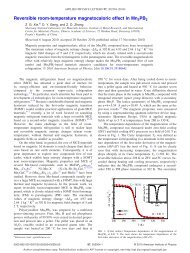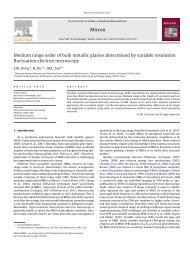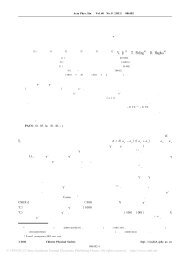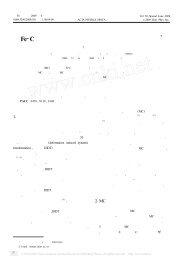Controlled hydrogen generation by reaction of aluminum/sodium ...
Controlled hydrogen generation by reaction of aluminum/sodium ...
Controlled hydrogen generation by reaction of aluminum/sodium ...
Create successful ePaper yourself
Turn your PDF publications into a flip-book with our unique Google optimized e-Paper software.
international journal <strong>of</strong> <strong>hydrogen</strong> energy 37 (2012) 5811e5816<br />
Available online at www.sciencedirect.com<br />
journal homepage: www.elsevier.com/locate/he<br />
<strong>Controlled</strong> <strong>hydrogen</strong> <strong>generation</strong> <strong>by</strong> <strong>reaction</strong> <strong>of</strong> <strong>aluminum</strong>/<br />
<strong>sodium</strong> hydroxide/<strong>sodium</strong> stannate solid mixture with water<br />
Guang-Lu Ma, Hong-Bin Dai*, Da-Wei Zhuang, Hai-Jie Xia, Ping Wang*<br />
Shenyang National Laboratory for Materials Science, Institute <strong>of</strong> Metal Research, Chinese Academy <strong>of</strong> Sciences, 72 Wenhua Road,<br />
Shenyang 110016, PR China<br />
article info<br />
Article history:<br />
Received 1 November 2011<br />
Received in revised form<br />
22 December 2011<br />
Accepted 29 December 2011<br />
Available online 23 January 2012<br />
Keywords:<br />
Hydrogen storage<br />
Hydrogen <strong>generation</strong><br />
Aluminum<br />
Kinetics<br />
abstract<br />
Aluminum/water <strong>reaction</strong> system has gained considerable attention for potential<br />
<strong>hydrogen</strong> storage applications. In this paper, we report a new <strong>aluminum</strong>-based <strong>hydrogen</strong><br />
<strong>generation</strong> system that is composed <strong>of</strong> <strong>aluminum</strong>/<strong>sodium</strong> hydroxide/<strong>sodium</strong> stannate<br />
solid mixture and water. This new system is characterized <strong>by</strong> the features as follows: the<br />
combined usage <strong>of</strong> <strong>sodium</strong> hydroxide and <strong>sodium</strong> stannate promoters, the use <strong>of</strong> solid fuel<br />
in a tablet form and the direct use <strong>of</strong> water as a <strong>reaction</strong> controlling agent. The factors that<br />
influence the <strong>hydrogen</strong> <strong>generation</strong> performance <strong>of</strong> the system were investigated. The<br />
optimized system exhibits a favorable combination <strong>of</strong> high <strong>hydrogen</strong> <strong>generation</strong> rate, high<br />
fuel conversion, rapid dynamic response, which makes it promising for portable <strong>hydrogen</strong><br />
source applications.<br />
Copyright ª 2012, Hydrogen Energy Publications, LLC. Published <strong>by</strong> Elsevier Ltd. All rights<br />
reserved.<br />
1. Introduction<br />
Hydrogen storage is widely recognized as the most technically<br />
challenging barrier to the implementation <strong>of</strong> <strong>hydrogen</strong> fuel cell<br />
technology. The last few decades have witnessed the discovery<br />
<strong>of</strong> many novel solid materials that can reversibly store<br />
<strong>hydrogen</strong> [1]. But unfortunately, the research efforts on these<br />
materials have led to no viable systems that can reversibly<br />
store over 6 wt% <strong>hydrogen</strong> under relevant conditions to the<br />
practical operation <strong>of</strong> proton exchange membrane fuel cell.<br />
Recently, the <strong>hydrogen</strong>-rich chemical hydrides received everincreasing<br />
attention as potential <strong>hydrogen</strong> storage media.<br />
Extensive studies <strong>of</strong> the representative chemical hydrides (e.g.<br />
<strong>sodium</strong> borohydride and ammonia borane) have given rise to<br />
a number <strong>of</strong> material systems that exhibit rapid and controlled<br />
H 2 release at moderate temperatures [2e6]. But the viability <strong>of</strong><br />
any chemical <strong>hydrogen</strong> storage system depends not only on its<br />
de<strong>hydrogen</strong>ation performance, but also on the recyclability <strong>of</strong><br />
the hydride materials. Currently, owing to the lack <strong>of</strong> energyefficient<br />
and cost-effective routes for spent fuel re<strong>generation</strong>,<br />
the boron-containing chemical hydrides are greatly limited in<br />
the practical <strong>hydrogen</strong> storage applications [2]. This situation<br />
has motivated the development <strong>of</strong> affordable <strong>hydrogen</strong><br />
<strong>generation</strong> (HG) system using cheap and/or renewable materials.<br />
Here, <strong>aluminum</strong> (Al) is clearly a preferred choice [7,8].<br />
Al þ 3H 2 O/AlðOHÞ 3<br />
Y þ 1:5H 2 [ þ 426:5kJ (1)<br />
Al reacts with H 2 O following Eq. (1), yielding 3.7 wt% H 2 .<br />
Although the gravimetric <strong>hydrogen</strong> density is moderately low,<br />
the Al/H 2 O system has many favorable attributes that make it<br />
an attractive candidate for portable applications. Al is an<br />
abundant, inexpensive and readily available material. HG<br />
from the Al/H 2 O <strong>reaction</strong> occurs in a self-sustaining way<br />
without external providing energy at ambient temperature.<br />
Furthermore, the environmentally benign <strong>by</strong>-products<br />
generated in the Al/H 2 O <strong>reaction</strong> can be recycled back to<br />
* Corresponding authors. Tel.: þ86 24 2397 1622; fax: þ86 24 2389 1320.<br />
E-mail addresses: hbdai@imr.ac.cn (H.-B. Dai), pingwang@imr.ac.cn (P. Wang).<br />
0360-3199/$ e see front matter Copyright ª 2012, Hydrogen Energy Publications, LLC. Published <strong>by</strong> Elsevier Ltd. All rights reserved.<br />
doi:10.1016/j.ijhydene.2011.12.157
5812<br />
international journal <strong>of</strong> <strong>hydrogen</strong> energy 37 (2012) 5811e5816<br />
metallic Al using well-established technologies [8,9]. But the<br />
development <strong>of</strong> Al/H 2 O system as practical <strong>hydrogen</strong> source<br />
requires a solution to the long-standing problem <strong>of</strong> surface<br />
passivation <strong>of</strong> Al. Currently, there are a number <strong>of</strong> approaches<br />
under investigation, which can be divided into two categories:<br />
one is addition <strong>of</strong> hydroxides [10,11], metal oxides [12,13] or<br />
selected salts [14,15] to disrupt the passivation layer; the other<br />
is alloying Al with low melting point metals to inhibit the<br />
formation <strong>of</strong> a coherent passivation layer [16e19]. In our study<br />
<strong>of</strong> the Al/H 2 O <strong>reaction</strong> system, we mainly focused on the alkali<br />
approach because the alkali-promoted system always<br />
outperforms other systems in terms <strong>of</strong> HG kinetics. But<br />
meanwhile, the use <strong>of</strong> alkali promoter causes corrosion <strong>of</strong> the<br />
system apparatus. From a practical point <strong>of</strong> view, novel<br />
technologies that enable minimization <strong>of</strong> alkali concentration<br />
without compromising <strong>of</strong> HG performance are highly<br />
desirable.<br />
Quite recently, our study found that a combined usage <strong>of</strong><br />
NaOH and Na 2 SnO 3 can dramatically improve the HG<br />
kinetics <strong>of</strong> the Al/H 2 Osystem[20]. Furthermore, the addition<br />
<strong>of</strong> a small amount <strong>of</strong> Na 2 SnO 3 causes a remarkable decrease<br />
<strong>of</strong> NaOH concentration that is required for achieving favorable<br />
HG performance. This finding provides a simple but<br />
effective method for simultaneously addressing the <strong>reaction</strong><br />
kinetics and alkali corrosion problems <strong>of</strong> the Al/H 2 O system.<br />
Stimulated <strong>by</strong> this finding, we further investigated a new<br />
system, which is composed <strong>of</strong> Al/NaOH/Na 2 SnO 3 solid<br />
mixture and H 2 O. In comparison with the traditional Al/H 2 O<br />
system using aqueous NaOH solution, the new system<br />
exhibits a series <strong>of</strong> advantages on HG performance, manipuility<br />
and adaptability, which makes it promising for<br />
portable <strong>hydrogen</strong> source applications. We herein show the<br />
study results.<br />
2. Experimental<br />
2.1. Preparation <strong>of</strong> solid fuel and sample<br />
characterization<br />
Al powder (99% purity), NaOH (98% purity) and <strong>sodium</strong> stannate<br />
trihydrate (Na 2 SnO 3 $3H 2 O, 99% purity) were purchased<br />
from Sinopharm Chemical Reagent Corporation. In the<br />
present study, a series <strong>of</strong> Al powder samples with different<br />
particle sizes were employed and characterized <strong>by</strong> a Mastersizer<br />
2000 particle size analyzer. Anhydrous <strong>sodium</strong> stannate<br />
(Na 2 SnO 3 ) was prepared <strong>by</strong> calcining Na 2 SnO 3 $3H 2 O at 350 C<br />
for 1 h.<br />
The Al/NaOH/Na 2 SnO 3 powder mixtures in varied mass<br />
ratios were hand-milled using a glass mortar and pestle or<br />
mechanically milled <strong>by</strong> a Fritsch 7 planetary mill at 400 rpm<br />
for 1 h. After the ball-milling, the solid fuel mixture was<br />
pressed into a tablet <strong>by</strong> a pellet machine at 10 MPa for 10 min.<br />
The diameter and height <strong>of</strong> the resulting tablet were 15 and<br />
3 mm, respectively.<br />
The solid residue <strong>of</strong> the Al/H 2 O <strong>reaction</strong> was analyzed <strong>by</strong><br />
powder X-ray diffraction (XRD, Rigaku D/max-2500, Cu Ka<br />
radiation). In preparation <strong>of</strong> the XRD samples, the solid<br />
residue was dried at 80 C under a dynamic vacuum condition<br />
for 48 h.<br />
2.2. Hydrogen <strong>generation</strong> performance testing<br />
The experimental setup used for measurement <strong>of</strong> HG properties<br />
has been described in a previous paper [21]. The <strong>reaction</strong><br />
was carried out in a 250 ml three-neck flask, wherein the solid<br />
fuel was preloaded. The water was fed into contact with the<br />
solid fuel using a pressure-equalizing dropping funnel. Typically,<br />
the feeding rate <strong>of</strong> water was controlled at around<br />
10 g min 1 . The generated <strong>hydrogen</strong> gas passed through<br />
a trap/heat exchanger to cool to room temperature followed<br />
<strong>by</strong> contacting with a silica drier to remove the moisture in the<br />
gas stream. The HG rate was measured using an online mass<br />
flow meter (Sevenstar Huachang, MFM D07e7BM, accuracy<br />
within 2%) that was equipped with a computer. The HG<br />
volume was calculated <strong>by</strong> integrating the measured HG rate<br />
over time. In the whole testing process, no attempt was made<br />
to control the temperature <strong>of</strong> the <strong>reaction</strong> system. The <strong>reaction</strong><br />
temperature was monitored using a thermocouple<br />
embedded in the solid fuel and recorded using an online<br />
recorder. Each experiment was repeated twice. The determined<br />
relative error was no more than 5%.<br />
3. Results and discussion<br />
3.1. Development <strong>of</strong> a new Al-based <strong>hydrogen</strong><br />
<strong>generation</strong> system<br />
The newly developed HG system is composed <strong>of</strong> Al/NaOH/<br />
Na 2 SnO 3 solid mixture and water. In comparison with the<br />
previous systems that use aqueous solution <strong>of</strong> promoting<br />
additives, the present system using water as a <strong>reaction</strong><br />
controlling agent is clearly <strong>of</strong> increased practicability. As<br />
shown in Fig. 1, feeding water into contact with the Al/NaOH/<br />
Na 2 SnO 3 solid fuel rapidly initiates vigorous H 2 release. The<br />
system can complete a 100% fuel conversion within 3 min<br />
with a maximum HG rate <strong>of</strong> 1740 ml min 1 . In contrast, the<br />
systems containing the same mass <strong>of</strong> individual NaOH or<br />
Fig. 1 e A comparison <strong>of</strong> the HG rate (top) and yield<br />
(bottom) among the systems: (a) 1 g <strong>of</strong> Al powder/0.2 g <strong>of</strong><br />
NaOH/0.1 g <strong>of</strong> Na 2 SnO 3 /5 g <strong>of</strong> H 2 O; (b) 1 g <strong>of</strong> Al powder/0.3 g<br />
<strong>of</strong> NaOH/5 g <strong>of</strong> H 2 O; (c) 1 g <strong>of</strong> Al powder/0.3 g <strong>of</strong> Na 2 SnO 3 /5 g<br />
<strong>of</strong> H 2 O.
international journal <strong>of</strong> <strong>hydrogen</strong> energy 37 (2012) 5811e5816 5813<br />
Na 2 SnO 3 additive can only fulfill a 60e70% fuel conversion<br />
within 8 min, and the maximum HG rates <strong>of</strong> the two systems<br />
are 860 and 280 ml min 1 , respectively. These results are<br />
consistent with the previous finding [20], showing the<br />
advantage <strong>of</strong> the combined usage <strong>of</strong> NaOH and Na 2 SnO 3<br />
additives in promoting Al/H 2 O <strong>reaction</strong>.<br />
Examination <strong>of</strong> the HG kinetics curves in Fig. 1 found that<br />
the system containing NaOHþNa 2 SnO 3 additives shows one<br />
major HG event, whereas the system containing 0.3 g NaOH<br />
additive exhibits two separated HG steps. This finding clearly<br />
indicates that addition <strong>of</strong> Na 2 SnO 3 causes a significant change<br />
<strong>of</strong> Al/H 2 O <strong>reaction</strong> behavior. In our effort to understand these<br />
phenomena, we first conducted a series <strong>of</strong> control experiments<br />
to gain insight into the <strong>reaction</strong> behavior <strong>of</strong> Al/NaOH/<br />
H 2 O system. Fig. 2 presents a comparison <strong>of</strong> the HG kinetics <strong>of</strong><br />
the Al/H 2 O system containing different quantities <strong>of</strong> NaOH<br />
additive. It was found that the systems containing 0.3e0.8 g <strong>of</strong><br />
NaOH, corresponding to 1.5e4 M with respect to water, show<br />
two HG steps and the time interval between the two steps is in<br />
inverse proportion to the NaOH quantity. When the addition<br />
quantity <strong>of</strong> NaOH is beyond this critical range, the system<br />
exhibits only one HG step. These results clearly show that the<br />
quantity <strong>of</strong> NaOH or OH concentration plays a decisive role in<br />
the two step HG phenomenon. For a given system containing<br />
moderate quantity <strong>of</strong> NaOH, the termination and restart <strong>of</strong> the<br />
HG <strong>reaction</strong> should originate from the variation <strong>of</strong> local OH<br />
concentration. Presumably, it is the mass transfer factor that<br />
causes variation <strong>of</strong> OH concentration, as discussed below.<br />
Al þ 4OH /AlðOHÞ 4<br />
þ 3e E 0 ¼ 2:310V (2)<br />
3H 2 O þ 3e /1:5H 2 [ þ 3OH E 0 ¼ 0:828V (3)<br />
AlðOHÞ 4<br />
4AlðOHÞ 3<br />
Y þ OH (4)<br />
The Al/H 2 O <strong>reaction</strong> in the presence <strong>of</strong> hydroxide involves<br />
formation <strong>of</strong> aluminate, water reduction and the reversible<br />
decomposition <strong>of</strong> Al(OH) 4 [22], as described <strong>by</strong> Eqs. (2)e(4).<br />
Although the overall HG <strong>reaction</strong> consumes no OH (as<br />
expressed <strong>by</strong> Eq. (1)), considerable amount <strong>of</strong> OH is trapped<br />
in the form <strong>of</strong> Al(OH) 4 owing to its relatively slow re<strong>generation</strong><br />
rate following Eq. (4). More importantly, the local accumulation<br />
<strong>of</strong> Al(OH) 4 ions may block the diffusion <strong>of</strong> OH to the<br />
<strong>reaction</strong> region. A combination <strong>of</strong> these two factors may cause<br />
gradual decrease <strong>of</strong> OH concentration in the vicinity <strong>of</strong> Al<br />
surface. As a consequence, both the HG rate and dissolution<br />
rate <strong>of</strong> Al(OH) 3 will be reduced. This may ultimately result in<br />
the formation <strong>of</strong> coherent Al(OH) 3 passivation layer on the<br />
surface <strong>of</strong> Al and the termination <strong>of</strong> HG <strong>reaction</strong>. Once the<br />
Al(OH) 4 “barrier layer” is diminished due to dilution, OH may<br />
gain access again to the Al surface. If the OH concentration is<br />
high enough for disrupting the Al(OH) 3 passivation layer, the<br />
Al/H 2 O <strong>reaction</strong> can be restarted. This hypothesis can well<br />
explain the observed effect <strong>of</strong> OH concentration on the HG<br />
behavior <strong>of</strong> the Al/H 2 O system. For example, increasing the<br />
quantity <strong>of</strong> NaOH additive will result in an increase <strong>of</strong> the<br />
mass transfer rate <strong>of</strong> OH ion, and there<strong>by</strong> shortening the<br />
time interval for restarting the HG <strong>reaction</strong>. When the quantity<br />
<strong>of</strong> NaOH is higher than the critical range, a 100% fuel<br />
conversion can be completed before the cohesive Al(OH) 3<br />
passivation layer is formed. In another extreme case, the low<br />
OH concentration is insufficient for disrupting the formed<br />
Al(OH) 3 passivation layer, there<strong>by</strong> prohibiting the occurrence<br />
<strong>of</strong> the second HG event.<br />
4Al þ 3SnðOHÞ 2 6 /4AlðOHÞ 4 þ 3Sn þ 2OH E0 ¼ 1:41V (5)<br />
The stepwise HG is undesirable for practical <strong>hydrogen</strong><br />
storage applications as it may cause problematic HG controllability<br />
<strong>of</strong> Al/H 2 O <strong>reaction</strong> system. Our study showed that the<br />
combined usage <strong>of</strong> NaOH and Na 2 SnO 3 additives provides<br />
a simple approach for addressing this problem. The rationale<br />
behind this approach is to inhibit the formation <strong>of</strong> cohesive<br />
Al(OH) 3 passivation layer on the surface <strong>of</strong> Al. As seen in Fig. 3,<br />
XRD analysis <strong>of</strong> the post-reacted Al/NaOH/Na 2 SnO 3 /H 2 O<br />
system clearly identified Al(OH) 3 and AlO(OH) <strong>by</strong>-products, as<br />
well as metallic Sn. The formation <strong>of</strong> metallic Sn from<br />
Na 2 SnO 3 , which exists in form <strong>of</strong> Na þ and [Sn(OH) 6 ] 2 in the<br />
alkaline solution, can be described <strong>by</strong> Eq. (5). The in situ<br />
formed Sn particles may combine with Al to construct<br />
numerous microgalvanic cells to accelerate the Al/H 2 O <strong>reaction</strong>.<br />
More importantly, the deposited metallic Sn on the<br />
Fig. 2 e Effects <strong>of</strong> NaOH concentration on the HG rate (top)<br />
and yield (bottom) <strong>of</strong> the system containing 1 g <strong>of</strong> Al<br />
powder and x g <strong>of</strong> NaOH (x [ 0.2, 0.3, 0.5, 0.8 and 1.2) and<br />
5g<strong>of</strong>H 2 O.<br />
Fig. 3 e XRD pattern <strong>of</strong> the solid residue that was collected<br />
after HG <strong>reaction</strong> <strong>of</strong> the system.
5814<br />
international journal <strong>of</strong> <strong>hydrogen</strong> energy 37 (2012) 5811e5816<br />
surface <strong>of</strong> Al may prevent the formation <strong>of</strong> cohesive Al(OH) 3<br />
passivation layer. As a consequence, the Al/H 2 O <strong>reaction</strong> can<br />
proceed in a continuous way, even in the presence <strong>of</strong> low OH<br />
concentration.<br />
3.2. Study <strong>of</strong> <strong>hydrogen</strong> <strong>generation</strong> properties <strong>of</strong> the Al/<br />
NaOH/Na 2 SnO 3 /H 2 O system<br />
As demonstrated, the newly developed Al/NaOH/Na 2 SnO 3 /<br />
H 2 O system possesses a series <strong>of</strong> advantages over the traditional<br />
NaOH-promoted system in terms <strong>of</strong> HG performance.<br />
To evaluate its potential for practical <strong>hydrogen</strong> storage<br />
applications, we further conducted a systematic study <strong>of</strong> the<br />
factors that influence the HG performance <strong>of</strong> the system. The<br />
first factor we examined is the NaOH:Na 2 SnO 3 mass ratio. For<br />
comparison purpose, the quantities <strong>of</strong> Al, H 2 O and promoting<br />
additives were fixed at 1, 5 and 0.3 g, respectively. As seen in<br />
Fig. 4, changing the NaOH:Na 2 SnO 3 mass ratio from 2:1 to 1:2<br />
results in a decrease <strong>of</strong> the HG rate and yield, showing that the<br />
system containing 0.2 g <strong>of</strong> NaOH and 0.1 g <strong>of</strong> Na 2 SnO 3 shows<br />
the best HG performance.<br />
Next, we examined the effect <strong>of</strong> the particle size <strong>of</strong> Al<br />
powder on the HG performance <strong>of</strong> the system. As seen in<br />
Table 1, both the HG rate and yield increase with reducing the<br />
particle size <strong>of</strong> Al powder. This should be ascribed to the<br />
variation <strong>of</strong> the surface area <strong>of</strong> Al. When using Al powder with<br />
an average particle size smaller than 68 mm, the system<br />
exhibited high HG rate and achieved 100% fuel conversion. In<br />
an overall consideration <strong>of</strong> the HG performance, material cost<br />
and availability, we selected the Al powder with an average<br />
particle size <strong>of</strong> 68 mm for further investigation.<br />
The newly developed HG system uses Al/NaOH/Na 2 SnO 3<br />
mixture as solid fuel. Our study found that the mixing state<br />
and form <strong>of</strong> the solid fuel exert important effect on the HG<br />
performance <strong>of</strong> the system. As shown in Fig. 5, pretreatment<br />
<strong>of</strong> the solid fuel <strong>by</strong> ball-milling instead <strong>of</strong> hand-milling results<br />
in an increase <strong>of</strong> HG rate and a reduction <strong>of</strong> induction period.<br />
This should be mainly attributed to the improved dispersion<br />
Table 1 e Effect <strong>of</strong> the particle size <strong>of</strong> Al powder on the HG<br />
performance <strong>of</strong> the Al-based system. Note: the Al-based<br />
system is composed <strong>of</strong> 1 g <strong>of</strong> Al powder, 0.2 g <strong>of</strong> NaOH,<br />
0.1 g <strong>of</strong> Na 2 SnO 3 and 5 g <strong>of</strong> H 2 O.<br />
Average particle<br />
size <strong>of</strong> Al (mm)<br />
Max. HG rate<br />
(ml min 1 g 1 Al)<br />
Yield (%)<br />
278 410 83.4<br />
198 515 85.2<br />
152 740 88.3<br />
125 1025 94.3<br />
68 1740 100<br />
16 2100 100<br />
<strong>of</strong> promoting additives in the solid fuel. In addition, the<br />
extensive mechanical milling may create increased opportunity<br />
for the close contact between the additive particles and<br />
the fresh surface <strong>of</strong> Al, which should also contribute to the<br />
improvements <strong>of</strong> HG performance. In spite <strong>of</strong> the clear benefits<br />
on HG performance, the solid fuel in powder form is<br />
undesirable for the practical <strong>hydrogen</strong> storage application due<br />
to the poor operationality, safety concern, as well as the<br />
complicated system design. For this reason, we pressed the<br />
ball-milled fuel powder into the tablets. As seen in Fig. 5, the<br />
system using the solid fuel tablets shows a similar HG rate, but<br />
a much longer induction period than those <strong>of</strong> the systems<br />
using solid powder fuel. Our preliminary study found that this<br />
problem can be alleviated <strong>by</strong> adding small amount <strong>of</strong> Al<br />
powder. For example, extra addition <strong>of</strong> 0.2 g <strong>of</strong> Al powder into<br />
the system containing 1.3 g <strong>of</strong> solid fuel tablet leads to<br />
a reduction <strong>of</strong> induction period from 1 to 0.5 min, as shown in<br />
Fig. 5(d).<br />
Finally, we examined the effect <strong>of</strong> water type on the HG<br />
performance <strong>of</strong> the system. As seen in Fig. 6, changing the<br />
water type from deionized water to tap water exerts no<br />
appreciable influence on the HG performance <strong>of</strong> the system.<br />
Among the three types <strong>of</strong> water we examined, the sea water<br />
containing 3.5 wt% <strong>of</strong> NaCl is the best choice. In comparison<br />
Fig. 4 e Effects <strong>of</strong> the NaOH:Na 2 SnO 3 mass ratio on the HG<br />
rate (top) and yield (bottom) <strong>of</strong> the system. The quantities<br />
<strong>of</strong> Al, H 2 O and promoting additives were fixed at 1, 5 and<br />
0.3 g, respectively.<br />
Fig. 5 e Effect <strong>of</strong> pretreatment <strong>of</strong> the solid fuel on the HG<br />
kinetics <strong>of</strong> the system composed <strong>of</strong> 1 g <strong>of</strong> Al powder/0.2 g <strong>of</strong><br />
NaOH/0.1 g <strong>of</strong> Na 2 SnO 3 and 5 g <strong>of</strong> water: (a) hand-milled; (b)<br />
ball-milled; (c) ball-milled and pressed; (d) the system (c)<br />
with extra addition <strong>of</strong> 0.2 g <strong>of</strong> Al powder. The inset shows<br />
a photo <strong>of</strong> the solid fuel tablet with a density <strong>of</strong> 2.45 g cm L3 .
international journal <strong>of</strong> <strong>hydrogen</strong> energy 37 (2012) 5811e5816 5815<br />
with the system using deionized water, the system using sea<br />
water exhibits an around 10% increase on HG rate and<br />
a slightly shortened induction period. Presumably, the<br />
advantage <strong>of</strong> sea water over the other two types <strong>of</strong> water<br />
originates from the enriched chlorine ions, which may accelerate<br />
the dissolution <strong>reaction</strong> <strong>of</strong> the passivation layer on the<br />
Al surface [18]. Evidently, using water as a <strong>reaction</strong> controlling<br />
agent implies the wide applicability <strong>of</strong> the newly developed<br />
HG system.<br />
3.3. “Start/stop” <strong>hydrogen</strong> <strong>generation</strong> dynamics<br />
Rapid dynamic response to the highly varying <strong>hydrogen</strong><br />
demands is another prerequisite for a practical HG system. In<br />
the present study, we tested the dynamic response property <strong>of</strong><br />
the Al/NaOH/Na 2 SnO 3 /H 2 O system in a discontinuous HG<br />
process, which involves cyclic start/stop <strong>of</strong> water supply to<br />
the reactor containing solid fuel. To avoid the influence <strong>of</strong> fuel<br />
temperature on the HG performance, the reactor was cooled<br />
down to ambient temperature between each stop/start cycle.<br />
As shown in Fig. 7, feeding water into contact with the solid<br />
fuel immediately initiates vigorous H 2 release. In the first two<br />
cycles, the HG <strong>reaction</strong> reaches its maximum rate within<br />
around 1.3 min, and after switching <strong>of</strong>f the water supply, the<br />
HG <strong>reaction</strong> can be terminated within around 1 min. But in the<br />
third cycle, the system exhibits a multi-step HG behavior and<br />
requires a relatively long duration for terminating the HG<br />
<strong>reaction</strong>. Most likely, this should be ascribed to the deteriorated<br />
mass transfer environment, wherein the accumulated<br />
<strong>by</strong>-products block the water from contacting the unreacted Al.<br />
But despite <strong>of</strong> the property degradation, the HG <strong>reaction</strong> in the<br />
third cycle exhibits a maximum rate <strong>of</strong> 450 ml min 1 , which is<br />
75% <strong>of</strong> the level in the first cycle. After three start/stop cycles,<br />
the total HG yield <strong>of</strong> the system reaches up to 93%. In a general<br />
view, the newly developed system shows satisfactory<br />
dynamic response property. This is <strong>of</strong> clear significance for<br />
the design <strong>of</strong> practical <strong>hydrogen</strong> generator.<br />
Using the data obtained from “start/stop” HG dynamics<br />
measurement, we can estimate the power level <strong>of</strong> the newly<br />
developed system. If the new system is combined with<br />
Fig. 7 e “Start/stop” HG dynamics and temperature pr<strong>of</strong>iles<br />
<strong>of</strong> the system composed <strong>of</strong> three pieces <strong>of</strong> solid fuel tablets<br />
(as shown in the inset) and 15 g <strong>of</strong> water. The feeding rate<br />
<strong>of</strong> water was fixed at 2 g min L1 .<br />
a standard proton exchange membrane fuel cell operating at<br />
0.7 V, a HG rate <strong>of</strong> 500 ml min 1 is equivalent to a power level<br />
<strong>of</strong> 40 W. This can meet the power demands <strong>of</strong> some portable<br />
or mobile apparatus. Using the current price <strong>of</strong> primary Al, 2.4<br />
US$ per kg, as a calculation benchmark, the H 2 -production<br />
cost <strong>of</strong> the present system is estimated to be around 21 US$<br />
per kg H 2 [9]. This H 2 -production cost is much lower than<br />
those <strong>of</strong> the chemical <strong>hydrogen</strong> storage systems using boroncontaining<br />
chemicals [2,5].<br />
4. Conclusions<br />
Our study demonstrated a new Al-based <strong>hydrogen</strong> <strong>generation</strong><br />
system, which is composed <strong>of</strong> Al/NaOH/Na 2 SnO 3 solid mixture<br />
and water. As a consequence <strong>of</strong> the pronounced promoting<br />
effects <strong>of</strong> NaOH and Na 2 SnO 3 additives, the on-demand<br />
<strong>hydrogen</strong> <strong>generation</strong> can be readily achieved <strong>by</strong> regulating<br />
the water supply to the solid fuel. The new system possesses<br />
a favorable combination <strong>of</strong> high <strong>hydrogen</strong> <strong>generation</strong> rate,<br />
high fuel conversion, rapid dynamic response and low material<br />
cost, which makes it promising for portable <strong>hydrogen</strong> source<br />
applications. In addition, the use <strong>of</strong> solid fuel in a tablet form<br />
and the adaptability to different types <strong>of</strong> water greatly increase<br />
the applicability <strong>of</strong> the new system. Our study shows the<br />
feasibility <strong>of</strong> achieving high-performance <strong>hydrogen</strong> <strong>generation</strong><br />
using cheap and readily available materials, there<strong>by</strong> laying<br />
a foundation for developing practical <strong>hydrogen</strong> generators.<br />
Acknowledgments<br />
Fig. 6 e Effects <strong>of</strong> the type <strong>of</strong> water on the HG rate (top) and<br />
yield (bottom) <strong>of</strong> the system composed <strong>of</strong> a piece <strong>of</strong> solid<br />
fuel tablet (1 g <strong>of</strong> Al powder/0.2 g <strong>of</strong> NaOH/0.1 g <strong>of</strong> Na 2 SnO 3 )<br />
and 5 g <strong>of</strong> H 2 O.<br />
The financial supports for this research from the National<br />
Basic Research Program <strong>of</strong> China (973 program, Grant No.<br />
2010CB631305), the National Outstanding Youth Science<br />
Foundation <strong>of</strong> China (Grant No. 51125003), the National<br />
Natural Science Foundation <strong>of</strong> China (Grant No. 51071155), the<br />
Natural Science Foundation <strong>of</strong> Liaoning Province (Grant No.<br />
20102231), and the Main Direction Program <strong>of</strong> Knowledge<br />
Innovation <strong>of</strong> CAS are gratefully acknowledged.
5816<br />
international journal <strong>of</strong> <strong>hydrogen</strong> energy 37 (2012) 5811e5816<br />
references<br />
[1] Weidenthaler C, Felderh<strong>of</strong>f M. Solid-state <strong>hydrogen</strong> storage<br />
for mobile applications: quo vadis? Energy Environ Sci 2011;<br />
4:2495e502.<br />
[2] Wang P, Kang XD. Hydrogen-rich boron-containing materials<br />
for <strong>hydrogen</strong> storage. Dalton Trans 2008;40:5400e13.<br />
[3] Demirci UB, Miele P. Sodium borohydride versus ammonia<br />
borane, in <strong>hydrogen</strong> storage and direct fuel cell applications.<br />
Energy Environ Sci 2009;2:627e37.<br />
[4] Jiang HL, Singh SK, Yan JM, Zhang XB, Xu Q. Liquid-phase<br />
chemical <strong>hydrogen</strong> storage: catalytic <strong>hydrogen</strong> <strong>generation</strong><br />
under ambient conditions. Chem Sus Chem 2010;3:541e9.<br />
[5] Liang Y, Wang P, Dai H. Hydrogen <strong>generation</strong> from catalytic<br />
hydrolysis <strong>of</strong> <strong>sodium</strong> borohydride solution. Prog Chem 2009;<br />
21:2219e28.<br />
[6] Liu BH, Li ZP. A review: <strong>hydrogen</strong> <strong>generation</strong> from<br />
borohydride hydrolysis <strong>reaction</strong>. J Power Sources 2009;187:<br />
527e34.<br />
[7] Wang HZ, Leung DYC, Leung MKH, Ni M. A review on<br />
<strong>hydrogen</strong> production using <strong>aluminum</strong> and <strong>aluminum</strong> alloys.<br />
Renew Sust Energy Rev 2009;13:845e53.<br />
[8] Shkolnikov EI, Zhuk AZ, Vlaskin MS. Aluminum as energy<br />
carrier: feasibility analysis and current technologies<br />
overview. Renew Sust Energy Rev 2011;15:4611e23.<br />
[9] Petrovic J, Thomas G. Reaction <strong>of</strong> <strong>aluminum</strong> with water to<br />
produce <strong>hydrogen</strong>. A study <strong>of</strong> issues related to the use <strong>of</strong><br />
<strong>aluminum</strong> for on-board vehicular <strong>hydrogen</strong> storage. Version<br />
1.0. U. S. Department <strong>of</strong> Energy Report; 2008. Available at:<br />
http://www1.eere.energy.gov/<strong>hydrogen</strong>andfuelcells/pdfs/<br />
aluminium_water_ <strong>hydrogen</strong>.pdf.<br />
[10] Belitskus D. Reaction <strong>of</strong> <strong>aluminum</strong> with <strong>sodium</strong> hydroxide<br />
solution as a source <strong>of</strong> <strong>hydrogen</strong>. J Electrochem Soc 1970;117:<br />
1097e9.<br />
[11] Jung CR, Kundu A, Ku B, Gil JH, Lee HR, Jang JH. Hydrogen<br />
from aluminium in a flow reactor for fuel cell applications. J<br />
Power Sources 2008;175:490e4.<br />
[12] Deng ZY, Tang YB, Zhu LL, Sakka Y, Ye J. Effect <strong>of</strong> different<br />
modification agents on <strong>hydrogen</strong>-<strong>generation</strong> <strong>by</strong> the <strong>reaction</strong><br />
<strong>of</strong> Al with water. Int J Hydrogen Energ 2010;35:9561e8.<br />
[13] Dupiano P, Stamatis D, Dreizin EL. Hydrogen production <strong>by</strong><br />
reacting water with mechanically milled composite <strong>aluminum</strong>metal<br />
oxide powders. Int J Hydrogen Energ 2011;36:4781e91.<br />
[14] Skrovan J, Alfantazi A, Troczynski T. Enhancing <strong>aluminum</strong><br />
corrosion in water. J Appl Electrochem 2009;39:1695e702.<br />
[15] Soler L, Candela AM, Macanás J, Muñoz M, Casado J.<br />
Hydrogen <strong>generation</strong> from water and <strong>aluminum</strong> promoted<br />
<strong>by</strong> <strong>sodium</strong> stannate. Int J Hydrogen Energ 2010;35:1038e48.<br />
[16] Wang W, Chen DM, Yang K. Investigation on microstructure<br />
and <strong>hydrogen</strong> <strong>generation</strong> performance <strong>of</strong> Al-rich alloys. Int J<br />
Hydrogen Energ 2010;35:12011e9.<br />
[17] Ziebarth JT, Woodall JM, Kramer RA, Choi G. Liquid phaseenabled<br />
<strong>reaction</strong> <strong>of</strong> AleGa and AleGaeIneSn alloys with<br />
water. Int J Hydrogen Energ 2011;36:5271e9.<br />
[18] Fan MQ, Xu F, Sun LX. Hydrogen <strong>generation</strong> <strong>by</strong> hydrolysis<br />
<strong>reaction</strong> <strong>of</strong> ball-milled AleBi alloys. Energy Fuels 2007;21:<br />
2294e8.<br />
[19] Ilyukhina AV, Kravchenko OV, Bulychev BM, Shkolnikov EI.<br />
Mechanochemical activation <strong>of</strong> <strong>aluminum</strong> with gallams for<br />
<strong>hydrogen</strong> evolution from water. Int J Hydrogen Energ 2010;<br />
35:1905e10.<br />
[20] Dai HB, Ma GL, Xia HJ, Wang P. Reaction <strong>of</strong> aluminium with<br />
alkaline <strong>sodium</strong> stannate solution as a controlled source <strong>of</strong><br />
<strong>hydrogen</strong>. Energy Environ Sci 2011;4:2206e12.<br />
[21] Dai HB, Ma GL, Xia HJ, Wang P. Combined usage <strong>of</strong> <strong>sodium</strong><br />
borohydride and <strong>aluminum</strong> powder for high-performance<br />
<strong>hydrogen</strong> <strong>generation</strong>. Fuel Cells 2011;11:424e30.<br />
[22] Pyun SI, Moon SM. Corrosion mechanism <strong>of</strong> pure aluminium in<br />
aqueous alkaline solution. J Solid State Electr 2000;4:267e72.


